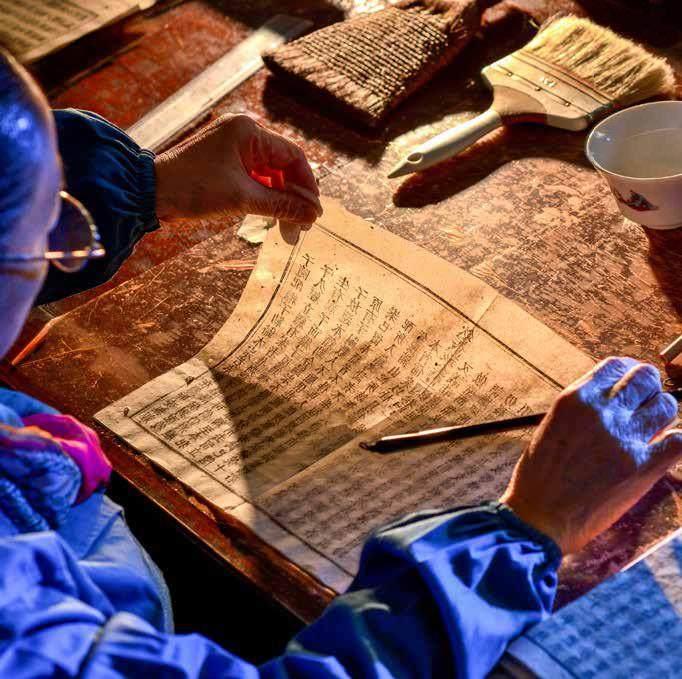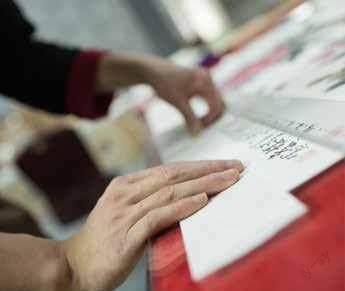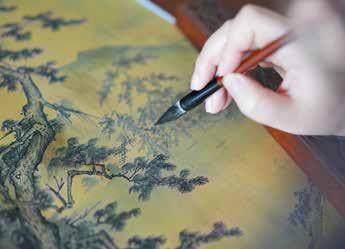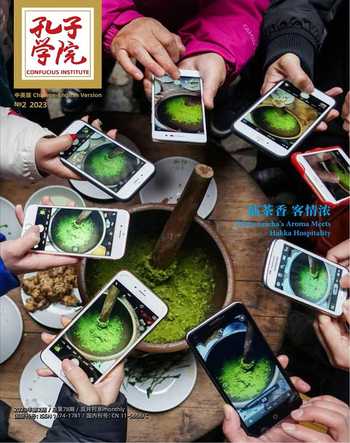中国传统书画装裱工艺中的修复技术
柳东溶



传统书画装裱工艺起源于中国,是一种历史悠久、集保护性与艺术性为一身的书画保护技艺。传统书画作品多选用纸或绢为材料,有着强度低、易老化的特点,因此不利于日常保存、展示和欣赏。传统书画装裱工艺大体可分为书画修复与装裱两项内容,修复指将有污染、残破等病害的书画作品进行复原;装裱指将书画作品与纸或丝绸通过小麦淀粉制成的糨糊拼接、粘合,再加以裁剪形成屏风、手卷、书页、立轴、镜片等不同形式。
The art of repairing and mounting artwork, which originates in China, issteeped in history, and serves both practical and artistic purposes. TraditionalChinese artwork is often crafted on delicate materials like paper or silk, which aresoft and prone to deterioration over time. This makes it difficult to preserve, display,and appreciate these precious pieces. Repairing artwork is composed of two maincomponents: restoration and mounting. Restoration involves repairing damaged orcontaminated works, while mounting entails using wheat starch paste to attach theartwork to paper or silk. The final product is then shaped into various forms such asscreens, handscrolls, pages, hanging scrolls, and mirror frames.
在 文物保护理论与技术愈发成熟的今日,一般“书画装裱”单指上述将书画作品加工为不同形式的传统工艺,而修复的概念也逐渐扩展甚至独立出来。按照文物保护基本原则中“不改变原状”的要求,如今对于未经装裱且存在病害的书画文物,一般只需进行修复;而已装裱好的书画文物出现病害后,除对其修复还需重新装裱。如今,故宫博物院、南京博物院等全国各级博物馆珍藏的无数传世和考古发掘获得的珍贵书画作品,都通过古书画修复技术与装裱工艺进行了复原,我们如今在博物馆得以一睹这些珍贵艺术品的风采。
As art preservation theories and techniquescontinue to evolve, the term “mounting”now specifically refers to the traditional craft oftransforming calligraphies and paintings intodifferent forms, while restoration has grown tobecome an independent concept. When preservingcultural relics, the basic principle is not to altertheir original state. If an unmounted artwork isdamaged, restoration alone is usually sufficient.However, if damage occurs to a mounted piece,both restoration and remounting are required.In museums throughout China, such as thePalace Museum and Nanjing Museum, usingancient restoration and mounting techniques, wecan reveal the beauty of precious artworks thathave been passed down through generations orexcavated through archaeological means.
古代關于书画修复技术的代表作有明代周嘉胄编写的《装潢志》,该书系统记载了古人关于传统书画装裱及修复技术的内容。以立轴形式书画作品为例,该书按照“洗、揭、补、衬边、小托、全、式、镶攒、覆、上壁、下壁、安轴、上杆、贴签”的顺序详细记录了此类书画的修复与装裱工序。这门古代传统工艺与现代博物馆馆藏书画文物的修复步骤并没有很大区别,但不同的是,如今馆藏文物保护会借助科学手段对其病害情况与材料进行分析检测,以选择更加安全稳妥的材料与工具,结合古代修复技术对书画文物进行修复,从而最大限度地延长文物寿命。
The most representative work on art repairingin ancient China is ZhuangHuang Zhi, edited by Zhou Jiachao in the MingDynasty. This book meticulously documentsvarious restoration techniques. According tothe book, repairing hanging scrolls involvesseveral steps, including cleaning, lifting, fixing,lining, adding support sheet, brushing, cutting,inlaying, covering, attaching the piece on thewall, taking the piece off the wall, attachingbottom roller, attaching top rod, and labeling.Although this traditional craft shares similaritieswith modern museum practices, there are somenotable differences. Today, in addition to ancienttechniques, museums also utilize scientificmethods to evaluate the condition of culturalrelics, including their materials, to select themost suitable materials and tools to protect them,thereby prolonging their lifespan.
本文以国家一级博物馆荆州博物馆馆藏的晚清张名倬的山水图装裱修复为例,说明书画装裱工艺中修复技术是如何应用于书画文物保护的。
I n this article, we describe the techniques used in the restoration of Chinese calligraphy and painting. Ourfocus will be on the repairing and mounting of a landscape painting by Zhang Mingzhuo, a distinguishedartist from the late Qing Dynasty, which is housed at the Jingzhou Museum, a museum of national significance.
1现状调查Assessment
荆州博物馆馆藏张名倬山水画作品,主要病害为水渍、污渍、折痕、变色、微生物病害、动物病害等。保存状况评估结果为病害严重,无法展示,如果不进行保护修复,会使病害继续发展,严重威胁文物的寿命。因此,此画急需保护修复。
This painting has suffered from a variety of ailments, including water stains, dirt, creases, discoloration,microbial damage, and pest damage. Upon assessment, its clear that the damage is quite severe, rendering thepainting unsuitable for display. Without prompt action, the harm will continue to worsen, posing a significant risk tothe paintings longevity. Its imperative that urgent repairs be carried out.
2清洗Cleaning
清洗指去除表面污染物、酸性物质和霉斑等危害性物质,一般选用蒸馏水,但清洗前须用3% —5% 比例的骨胶水对颜料或墨水进行固色,防止跑色或跑墨,否则会对文物造成不可逆的损伤。
Cleaning is the process of removing harmful substances such as surface contaminants,acidic compounds, and mold stains. Typically, distilled water is used for cleaning. However, itis important to first fix pigments or inks using a 3%–5% solution of bone glue to prevent colorbleeding or ink running. Failing to do so could result in irreversible damage to the painting.
3画芯修复Fixing
将清洗完成的书画作品,正面用蒸馏水和韧性好的手工纸进行“水托纸”处理,然后翻面從背面对各种病害导致的残缺部位进行修复。为避免与书画作品使用的纸张产生异质感,需用相同材质的纸张修复,修补纸张需比残缺部位略大,并用小麦淀粉糨糊粘贴。
After cleaning the piece, the front side is treated with“support paper” using distilled water and durable handmadepaper. Next, the work is turned over, and the damaged areascaused by various factors are mended from the back. Tomaintain the uniform texture of the original paper used in theartwork, the repair paper should be made of the same materialas the original. The size of the paper should be slightly biggerthan the damaged area and affixed using wheat starch paste.
4托画芯Mounting
在完成修复的书画作品背面均匀涂抹低浓度的小麦淀粉糨糊,将宣纸贴在背面并刷至平整不起褶。托画芯选用安徽省泾县产棉料宣纸,成分为占比40% 的青檀皮纤维和占比60%的沙田稻草纤维。将托好纸的裱件,吸干多余水分后用棕刷子排实,自然干燥。
After the painting is fixed,gently apply a low concentrationof wheat starch paste onthe back and carefully affix therice paper, ensuring it is free ofcreases. For the support rice paper,we chose cotton paper producedin Jingxian County, AnhuiProvince, which comprises40% ebony bark fiber and 60%straw fiber. Once the mountingis complete, remove excess waterand smooth the paper usinga bristle brush before leaving itto dry naturally.
5全色Retouching
在托好的干燥裱件正反面適当喷水,用小麦淀粉糨糊在背面四边涂1—2cm 的宽度,贴在干燥板上重新干燥。在修复部位涂3%—5% 浓度的胶矾水,干燥后使用传统颜料进行全色,使其与周围颜色相接近或略浅。
Firstly, moisten the dry mountedpiece by spraying water to its twosides. Next, apply a layer of wheatstarch paste that is about 1–2 cm widealong the four edges on the backside,and then mount it onto a dry board toallow it to dry again. Once the pieceis dry, apply a 3%–5% concentrationof alum gelatin solution to therepaired area. After this has dried,use traditional pigments to retouchthe damaged area, making sure itmatches the surrounding colors or isslightly lighter.
6装裱Framing
一般书画文物修复完成后,要从干燥板上分离裁剪,以修复之前的装裱形式重新装裱。但是上述书画文物未经装裱,因此在完成清洗、画芯修复、托画芯、全色后需要加以装裱。书画界常说“三分画,七分裱”,经装裱后的书画不仅更具艺术性,同时也便于收藏与展示,具有一定的保护作用,因而书画装裱是书画艺术中画龙点睛的一笔。为更直观地展示书画装裱,可以利用设计软件对其进行模拟一色立轴形式与两色立轴形式装裱,如图11 所示。
Once the repairs have been made,the artwork is taken off the dryingboard and framed in exact the samemanner as before the restoration process. Since the painting was not previouslyframed, this step can only be done aftercleaning, fixing, mounting, and retouchingare completed. It is often said that “properframing accounts for 70% of the overallaesthetic appeal of an artwork, while theremaining 30% is attributed to the paintingskills.” Framing not only increases the artisticvalue of the painting, but also makes it easierto collect and display the piece and providesa certain degree of protection. Thus, framingis considered the final touch to any artwork.To demonstrate the final effect, weuse design software to show how thepainting can be framed as a hangingscroll in one-color mount and twocolormount styles, as illustrated in thefigure below.
具有悠久历史的中国传统书画装裱工艺与修复技术,很难通过一篇短文就解释周全。希望读者通过本文介绍,了解作为中国非物质文化遗产的书画装裱工艺和修复技术,如今在国内外博物馆中是如何应用于书画文物保护的。这项珍贵的传统工艺被列为国家及地方非物质文化遗产,将得以继续发扬和更有利的传承。书画装裱工艺及修复技术所用的材料和工具等也将得到更多的关注,其传承的成果会更丰富、更系统。
E xplaining the intricaciesof the traditional Chineseart restoration techniques ina short article is quite challenging.Nonetheless, our goalis to offer readers a glimpseinto this intangible culturalheritage and how it is utilizedto safeguard artwork in museums,both locally and abroad.This invaluable traditionalcraft has been acknowledgedas a Chinese national and localintangible cultural heritage tobe passed down through generations.Hopefully, there willbe a growing focus on the materialsand tools used in thiscraft, leading to more sophisticatedand systematic methodsfor art preservation.
——辽宁省博物馆藏中国古代立轴山水画展
- 孔子学院的其它文章
- 二十四节气Twenty-four Solar Terms
- 二十四节气之惊蛰和春分Twenty-four Solar Terms
- 滕王阁, 因王勃而不朽Wang Bo’s Literary Genius Elevates the Pavilion of Prince Teng to Fame
- 不识庐山真面目Of Mountain Lu We Cannot Make Out the True Face
- 如何介绍南昌Teaching: Introducing Nanchang to International Students
- 汉语的教与学Teaching and Learning Chinese

